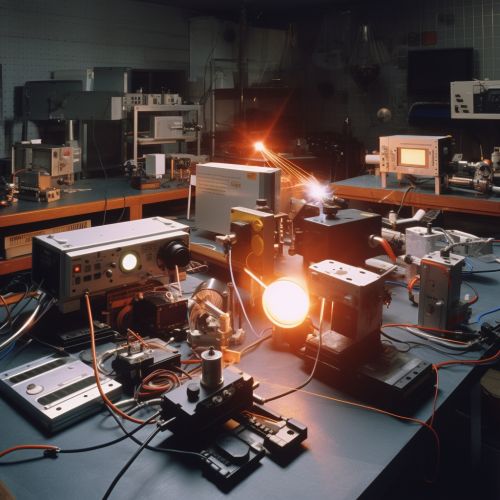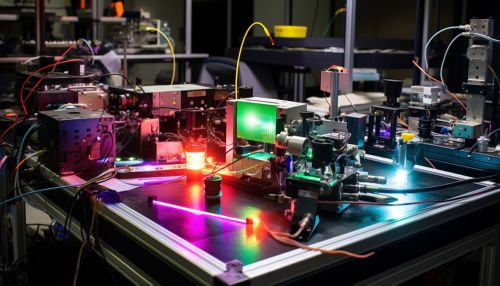Bell test experiments
Introduction
Bell test experiments or Bell's theorem experiments are types of physics experiments designed to test the predictions of quantum mechanical theories, specifically the concept of local realism. Named after physicist John Bell, who first proposed the theorem in 1964, these experiments play a crucial role in the field of quantum physics.


Background
The concept of local realism was a fundamental principle in classical physics, which states that physical processes occurring at one location do not depend on the properties of objects at other locations. However, quantum mechanics, a theory developed in the early 20th century to explain the behavior of particles at the atomic and subatomic level, seemed to violate this principle.
John Bell proposed a theorem, now known as Bell's theorem, that offers a test to determine whether or not the predictions of quantum mechanics regarding entangled particles are correct. Bell's theorem states that if the universe obeys local realism, then certain statistical correlations regarding the behavior of entangled particles should be observed. If these correlations are violated, then the universe must obey the predictions of quantum mechanics, which allow for instantaneous interactions between entangled particles, regardless of the distance separating them.
Bell's Theorem
Bell's theorem is based on the concept of quantum entanglement, a phenomenon in which two or more particles become linked and instantaneously affect each other's state, no matter how far apart they are. This seemed to violate the principle of local realism, as it implied a form of instantaneous communication, or "spooky action at a distance," as Albert Einstein famously described it.
Bell proposed a mathematical inequality, now known as Bell's inequality, that should hold if local realism is correct. This inequality involves the statistical correlations between measurements of certain properties of entangled particles, such as their spin or polarization. If the inequality is violated, it would suggest that local realism is incorrect and that quantum mechanics is right.
Experimental Tests
Since the proposal of Bell's theorem, many experimental tests have been conducted to test its predictions. These are known as Bell test experiments. The first of these was performed by physicists John Clauser, Michael Horne, Abner Shimony, and Richard Holt, and is known as the CHSH experiment.
In a typical Bell test experiment, a source produces pairs of entangled particles. These particles are then sent in opposite directions to two distant detectors. At each detector, a measurement is made of a particular property of the particles, such as their spin or polarization. The results of these measurements are then compared to see if they violate Bell's inequality.
Over the years, many Bell test experiments have been conducted, with varying degrees of success. Some of these experiments have shown violations of Bell's inequality, suggesting that local realism is incorrect. However, these experiments have also been subject to various "loopholes" that could potentially explain the observed results without violating local realism.
Loopholes and Their Closure
One of the main challenges in conducting Bell test experiments is the presence of various "loopholes" that could potentially affect the results. These loopholes represent possible ways in which the experimental results could be explained without violating local realism.
One of the most significant of these is the "detection loophole," which arises from the fact that in many experiments, not all of the entangled particles are detected. If the particles that are detected are not a representative sample of all the particles produced, this could potentially bias the results.
Another significant loophole is the "communication loophole," which arises if there is a possibility that the two detectors could communicate with each other during the time it takes for the particles to travel from the source to the detectors. This could potentially allow the detectors to "conspire" to produce correlated results.
Over the years, many experiments have been conducted to close these loopholes. In 2015, a team of researchers at the Delft University of Technology in the Netherlands reported the results of an experiment that closed both the detection and communication loopholes for the first time.
Implications and Interpretations
The results of Bell test experiments have profound implications for our understanding of the nature of reality. The violations of Bell's inequality observed in these experiments suggest that the universe does not obey local realism, a fundamental principle of classical physics.
This has led to various interpretations of quantum mechanics, each with its own philosophical implications. These include the Copenhagen interpretation, which suggests that the act of measurement causes the collapse of the quantum wave function; the many-worlds interpretation, which suggests that all possible outcomes of a quantum measurement actually occur in some "branch" of the universe; and the de Broglie-Bohm theory, which proposes a form of "hidden variables" to explain the observed results.
Conclusion
Bell test experiments represent a crucial test of the fundamental principles of quantum mechanics. Despite the various challenges and loopholes associated with these experiments, the results obtained so far seem to support the predictions of quantum mechanics over those of local realism. This has profound implications for our understanding of the nature of reality, and continues to be a subject of ongoing research in the field of quantum physics.
